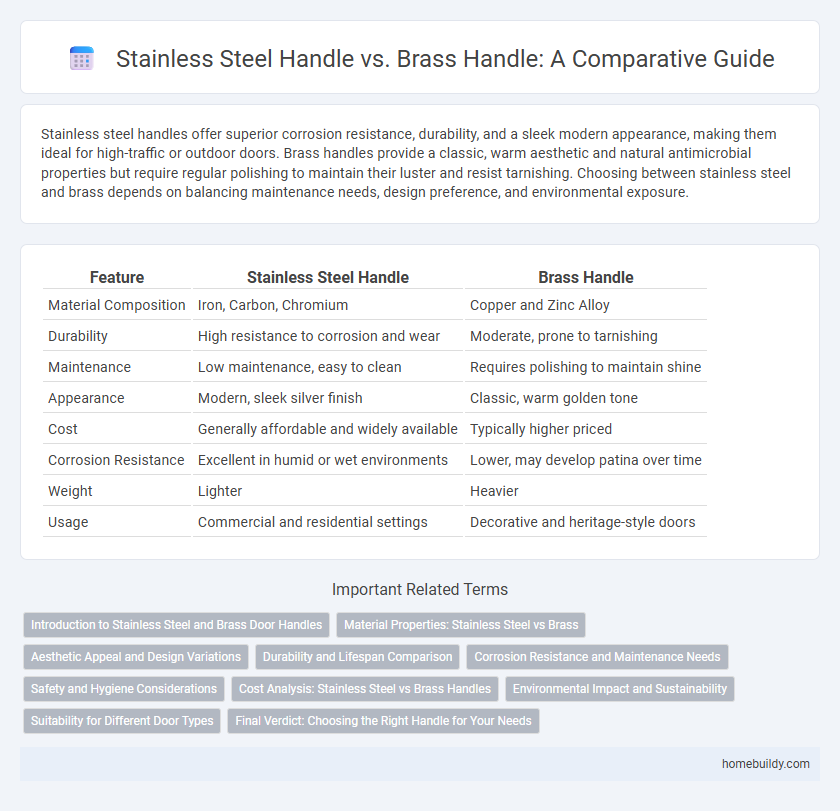Stainless steel handles offer superior corrosion resistance, durability, and a sleek modern appearance, making them ideal for high-traffic or outdoor doors. Brass handles provide a classic, warm aesthetic and natural antimicrobial properties but require regular polishing to maintain their luster and resist tarnishing. Choosing between stainless steel and brass depends on balancing maintenance needs, design preference, and environmental exposure.
Table of Comparison
| Feature | Stainless Steel Handle | Brass Handle |
|---|---|---|
| Material Composition | Iron, Carbon, Chromium | Copper and Zinc Alloy |
| Durability | High resistance to corrosion and wear | Moderate, prone to tarnishing |
| Maintenance | Low maintenance, easy to clean | Requires polishing to maintain shine |
| Appearance | Modern, sleek silver finish | Classic, warm golden tone |
| Cost | Generally affordable and widely available | Typically higher priced |
| Corrosion Resistance | Excellent in humid or wet environments | Lower, may develop patina over time |
| Weight | Lighter | Heavier |
| Usage | Commercial and residential settings | Decorative and heritage-style doors |
Introduction to Stainless Steel and Brass Door Handles
Stainless steel door handles offer superior corrosion resistance, durability, and a modern aesthetic, making them ideal for high-traffic and outdoor applications. Brass handles provide a classic, warm appearance with natural antimicrobial properties, often preferred for traditional or vintage interior designs. Both materials deliver distinct advantages in strength and style, catering to different architectural preferences and maintenance needs.
Material Properties: Stainless Steel vs Brass
Stainless steel handles offer superior corrosion resistance and high tensile strength, making them ideal for environments exposed to moisture and frequent use. Brass handles provide excellent antimicrobial properties and a classic aesthetic but are softer and more prone to tarnishing and wear over time. The choice between stainless steel and brass hinges on balancing durability, maintenance needs, and desired appearance for the door handle application.
Aesthetic Appeal and Design Variations
Stainless steel handles offer a sleek, modern aesthetic with a smooth, polished finish that complements contemporary interior designs, making them ideal for minimalist and industrial styles. Brass handles provide a warm, classic look with a natural golden hue that ages into a unique patina, enhancing vintage, traditional, or rustic decor themes. The design variations in stainless steel range from simple, geometric shapes to intricate patterns, while brass handles often feature detailed engravings and ornate designs that highlight craftsmanship.
Durability and Lifespan Comparison
Stainless steel door handles offer superior durability due to their resistance to corrosion, rust, and wear, making them ideal for high-traffic areas and outdoor use. Brass handles, while aesthetically pleasing and antimicrobial, tend to develop patina and require regular maintenance to prevent tarnishing and degradation over time. Overall, stainless steel handles provide a longer lifespan with minimal upkeep compared to brass handles that may need polishing and protection to maintain their appearance and functionality.
Corrosion Resistance and Maintenance Needs
Stainless steel door handles offer superior corrosion resistance due to their chromium content, which forms a protective oxide layer preventing rust and tarnish, making them ideal for high-humidity or outdoor environments. Brass handles, while aesthetically pleasing with their warm, classic look, require regular polishing to prevent oxidation and maintain their shine, as they are more prone to corrosion and patina over time. Stainless steel handles generally demand less maintenance, benefiting from durability and resistance to staining, whereas brass handles need consistent upkeep to preserve appearance and functionality.
Safety and Hygiene Considerations
Stainless steel handles offer superior resistance to corrosion and are less prone to harboring bacteria due to their non-porous surface, making them ideal for environments demanding high hygiene standards. Brass handles contain antimicrobial properties that naturally inhibit bacterial growth, but their softer metal composition can lead to wear and surface degradation, potentially compromising cleanliness over time. Selecting between stainless steel and brass handles depends on balancing long-term durability with inherent antimicrobial benefits for optimal safety and hygiene.
Cost Analysis: Stainless Steel vs Brass Handles
Stainless steel handles typically cost less upfront compared to brass handles due to lower material and manufacturing expenses, making them a budget-friendly choice for large-scale projects. Brass handles, while more expensive initially, offer superior durability and corrosion resistance, potentially reducing long-term replacement and maintenance costs. Considering lifecycle cost analysis, stainless steel provides an economical option for moderate use, whereas brass represents a more cost-effective investment for heavy-use environments requiring premium longevity.
Environmental Impact and Sustainability
Stainless steel door handles offer superior environmental sustainability due to their high recyclability and resistance to corrosion, which extends their lifespan and reduces waste. In contrast, brass handles require more energy-intensive mining and processing, contributing to a larger carbon footprint despite their durability. Choosing stainless steel supports eco-friendly building practices by minimizing resource depletion and promoting long-term material reuse.
Suitability for Different Door Types
Stainless steel handles offer excellent durability and corrosion resistance, making them ideal for exterior doors exposed to weather and heavy use, including commercial entrances and security doors. Brass handles, known for their classic aesthetic and antimicrobial properties, are better suited for interior doors where style and hygiene are prioritized, such as residential living spaces and office rooms. Choosing between stainless steel and brass handles depends on door material, usage frequency, and environmental conditions to ensure optimal performance and longevity.
Final Verdict: Choosing the Right Handle for Your Needs
Stainless steel handles offer superior durability, corrosion resistance, and modern aesthetics, making them ideal for high-traffic or outdoor environments. Brass handles provide a classic, elegant look with natural antimicrobial properties, suitable for traditional interiors and hygiene-conscious spaces. Selecting the right door handle depends on balancing factors like style preference, maintenance requirements, and the specific environment where the handle will be used.
Stainless steel handle vs Brass handle Infographic

 homebuildy.com
homebuildy.com